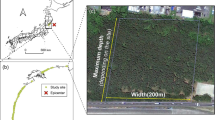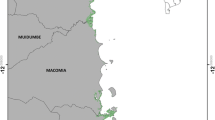Abstract
A field study using satellite images was carried out to analyze the effect of coastal vegetation in mitigating the impact of a catastrophic tsunami on coastal villages in the Biobío Region, Chile, in February 2010. Two types of stand, Pinus radiata D. Don forests and Cupressus macrocarpa Hartw. shelterbelts, appear to have protected coastal areas behind them from the direct impact of the tsunami. The impacts of the horizontal and vertical structures of these coastal forests on the drag forces were analyzed by observing the characteristics of Pinus radiata forests and Cupressus macrocarpa shelterbelts. The stands absorbed the impact of the tsunami without incurring broken stems or uprooted trees due to their diverse horizontal structure, as they contained short trees with various diameters. However, small areas of the stands were damaged by salinity after the tsunami. For this tsunami, which was less than 3 m high, the horizontal and vertical structures of the P. radiata and C. macrocarpa stands provided effective protection for coastal villages since they reduced the velocity and height of the tsunami. A shelterbelt consisting of three rows of C. macrocarpa in front of the tsunami and a P. radiata forest with a density of 11 trees/100 m2 and a width of >50 m immediately behind the shelterbelt are suggested as a means of protecting communities along the coastline of the Biobío Region against tsunamis.








Similar content being viewed by others
References
Contreras M, Winckler P (2013) Pérdidas de vidas, viviendas, infraestructura y embarcaciones por el tsunami del 27 de Febrero de 2010 en la costa central de Chile. Obras y Proyectos 14(1):6–19 (in Spanish)
Dahdouh-Guebas F, Jayatissa LP, Di Nitto D, Bosire JO, Lo Seen D, Koedam N (2005) How effective were mangroves as a defence against the recent tsunami? Curr Biol 15(14):1337–1338
Danielsen F, Sørensen MK, Olwig MF et al (2005) The Asian tsunami: a protective role for coastal vegetation. Science 310(5748):643
Del Pozo A, Del Canto S (1999) Areas agroclimáticas y sistemas productivos en la VII y VIII Regiones. Ministerio de Agricultura, Instituto de Investigaciones Agropecuarias, Centro Regional Quilamapu, Chillán (in Spanish)
GEER (2010) Geo-engineering reconnaissance of the 2010 Maule, Chile earthquake. In: Bray J, Frost D (eds) Report of NSF-Sponsored GEER Association Team. Geoengineering Extreme Events Reconnaissance (GEER) Association, Berkeley, pp 347
Harada K, Imamura F (2001) Experimental study on the resistance by mangrove under the unsteady flow. In: Proc 1st Congr Asian Pacific Coastal Eng Conf, Dalian, China, 23–25 Oct 2001, pp 975–984
Husrin S, Oumeraci H (2009) Parameterization of coastal forest vegetation and hydraulic resistance coefficients for tsunami modelling. In: Proc 4th Annu Int Workshop and Expo on Sumatra Tsunami Disaster and Recovery, Tsunami and Disaster Mitigation Research Center (TDMRC), Banda Aceh, Indonesia, 23–25 Nov 2009, pp 78–86
Iimura K, Tanaka N (2012) Numerical simulation estimating effects of tree density distribution in coastal forest on tsunami mitigation. Ocean Eng 54:223–232
Imai K, Matsutomi H (2005) Fluid force on vegetation due to tsunami flow on a sand spit. In: Satake K (ed) Tsunamis, advances in natural and technological hazards research. Springer, Dordrecht, pp 293–304
Kathiresan K, Rajendran N (2005) Coastal mangrove forests mitigated tsunami. Estuar Coast Shelf Sci 65(3):601–606
Kerr AM, Baird AH, Campbell SJ (2006) Comments on “Coastal mangrove forests mitigated tsunami” by K. Kathiresan and N. Rajendran [Estuar Coast Shelf Sci 65 (2005) 601–606]. Estuar Coast Shelf Sci 67(3):539–541
Koshimura S, Matsuoka M, Matsuyama M (2011) Field survey of the 2010 tsunami in Chile. In: Proc 8th Int Conf on Urban Earthquake Engineering, Tokyo, Japan, 7–8 March 2011, pp 1547–1558
Mascarenhas A, Jayakumar S (2008) An environmental perspective of the post-tsunami scenario along the coast of Tamil Nadu, India: role of sand dunes and forests. Environ Manag 89(1):24–34
Nandasena NAK, Tanaka N, Tanimoto K (2008) Tsunami current inundation of ground with coastal vegetation effects; an initial step towards a natural solution for tsunami amelioration. Earthq Tsunami 2(2):157–171
Nandasena NAK, Sasaki Y, Tanaka N (2012) Modelling field observations of the 2011 Great East Japan tsunami: efficiency of artificial and natural structures on tsunami mitigation. Coast Eng 67(1):1–13
Perry DA (1985) The competition process in forest stand. In: Cannell MGR, Jackson JE (eds) Attributes of trees as crop plants. Institute of Terrestrial Ecology, Natural Environment Research Council, Huntingdon, pp 481–506
Samarakoon MB, Tanaka N, Iimura K (2013) Improvement of effectiveness of existing Casuarina equisetifolia forests in mitigating tsunami damage. Environ Manag 114:105–114
Shuto N (1987) The effectiveness and limit of tsunami control forests. Coast Eng Jpn 30(1):143–153
Strusinska-Correia A, Husrin S, Oumeraci H (2013) Tsunami damping by mangrove forest: a laboratory study using parameterized trees. Nat Hazards Earth Syst Sci 13:483–503
Tanaka N (2009) Vegetation bioshields for tsunami mitigation: review of effectiveness, limitations, construction, and sustainable management. Landsc Ecol Eng 5(1):71–79
Tanaka N, Sasaki Y, Mowjood MIM, Jinadasa KBSN, Homchuen S (2007) Coastal vegetation structures and their functions in tsunami protection: experience of the recent Indian Ocean tsunami. Landsc Ecol Eng 3(1):33–45
Tanaka N, Istiyanto DC, Kuribayashi D (2010) Planning and design of tsunami-mitigative coastal vegetation belts. International Centre for Water Hazard and Risk Management under the auspices of UNESCO, Public Works Research Institute, Tsukuba
Tanaka N, Yasuda S, Iimura K, Yagisawa J (2014) Combined effects of coastal forest and sea embankment on reducing the washout region of houses in the Great East Japan tsunami. Hydroenviron Res 8(3):270–280
Vargas G, Farías M, Carretier S, Tassara A, Baize S, Melnick D (2011) Coastal uplift and tsunami effects associated to the 2010 Mw8.8 Maule earthquake in central Chile. Andean Geol 38(1):219–238
Yanagisawa H, Koshimura S, Goto K et al (2009) The reduction effects of mangrove forest on a tsunami based on field surveys at Pakarang Cape, Thailand and numerical analysis. Estuar Coast Shelf Sci 81(1):27–37
Zoa N, Salazar J, López JM (2010) Estudio de impacto de tsunami, 27 de febrero de 2010, bahía de Dichato, 8a Región, Chile. Bases para método de estudio y zonificación de áreas de riesgo. Geoengineering Extreme Events Reconnaissance (GEER) Association, Berkeley, p 23 (in Spanish)
Author information
Authors and Affiliations
Corresponding author
Rights and permissions
About this article
Cite this article
Rodríguez, R., Encina, P., Espinosa, M. et al. Field study on planted forest structures and their role in protecting communities against tsunamis: experiences along the coast of the Biobío Region, Chile. Landscape Ecol Eng 12, 1–12 (2016). https://doi.org/10.1007/s11355-015-0271-5
Received:
Revised:
Accepted:
Published:
Issue Date:
DOI: https://doi.org/10.1007/s11355-015-0271-5




